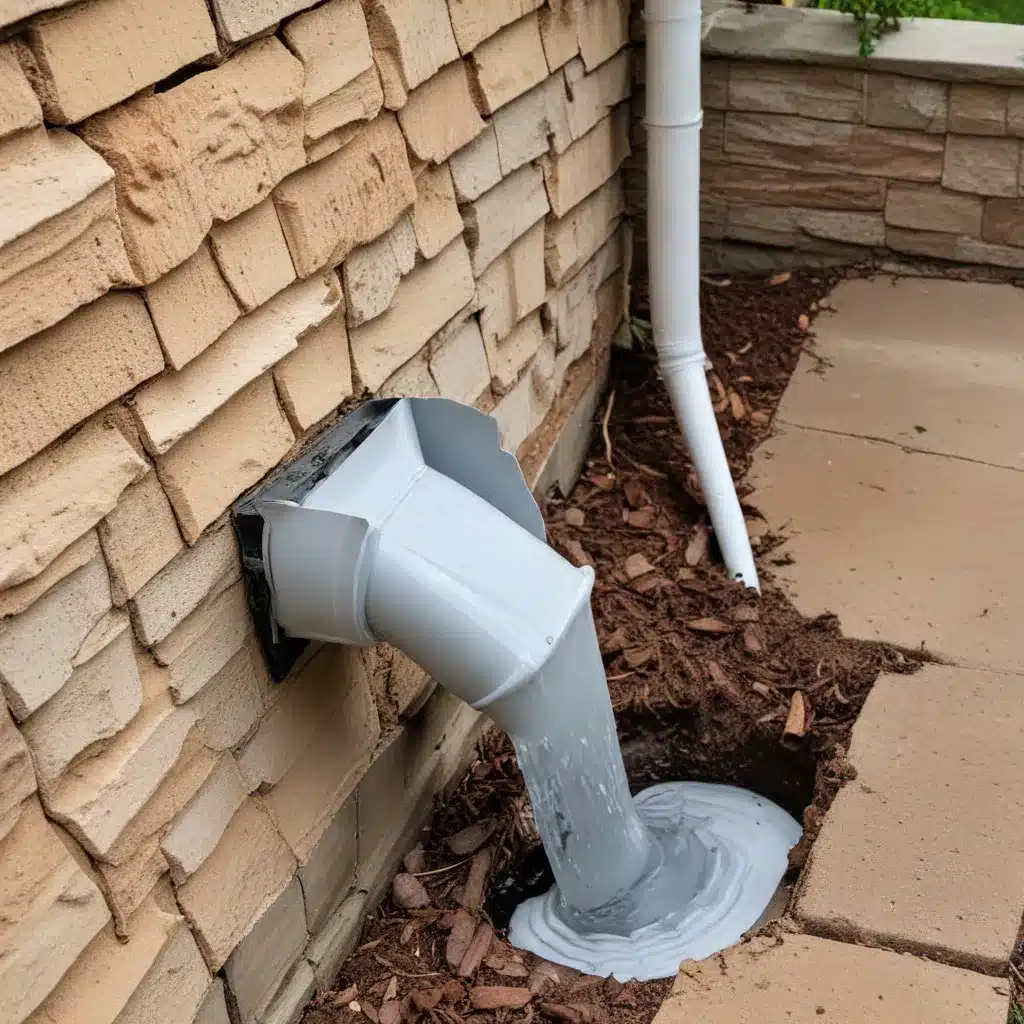
Conquering Basement Moisture: Identifying and Addressing the Root Causes
As a seasoned roofing professional, I’ve seen firsthand the devastating effects of improper water management around a home’s foundation. Basement moisture issues can lead to mold growth, structural damage, and even health concerns for occupants. In this comprehensive guide, we’ll dive deep into the common causes of downspout and drainage problems, and explore practical solutions to keep your home dry and secure.
Understanding the Sources of Basement Moisture
Basement moisture can stem from a variety of sources, both external and internal. Let’s first examine the key contributors:
-
Exterior Water Intrusion: Rainwater and groundwater are the primary culprits when it comes to basement moisture issues. Improper grading, missing or malfunctioning gutters and downspouts, and inadequate subsurface drainage systems can all channel water directly into the basement.
-
Condensation: Warm, humid air entering a cool basement can lead to condensation on the walls and floors, creating a damp environment. This is often exacerbated by activities like showering, cooking, and using humidifiers.
-
Capillary Action: Porous materials like concrete can draw moisture upwards through capillary action, leading to a telltale “ring of dampness” around the base of basement walls.
-
Vapor Diffusion: Moisture in the soil can diffuse through the concrete foundation, contributing to overall basement humidity.
Understanding the underlying causes is the first step in developing an effective solution. By addressing the root problems, you can prevent recurring issues and ensure a dry, healthy basement environment.
Rectifying Exterior Water Management Issues
One of the most crucial aspects of addressing basement moisture is properly managing exterior water drainage. Let’s explore some common problems and their corresponding solutions:
-
Improper Grading: If the ground around the foundation slopes towards the house, water will be directed into the basement. The solution is to regrade the soil, ensuring it slopes away from the foundation by a minimum of 1 inch per foot for at least 6 feet.
-
Missing or Malfunctioning Gutters and Downspouts: Gutters and downspouts play a vital role in channeling rainwater away from the foundation. Ensure you have a downspout every 50 linear feet of roof eave, and that the downspouts extend at least 4 feet beyond the wall to direct water away effectively.
-
Inadequate Subsurface Drainage: Many older homes lack proper subsurface drainage systems, or the existing systems may have become clogged or damaged over time. Installing a perimeter drainage system with a sump pump can help intercept and remove groundwater before it enters the basement.
-
Improperly Designed Window Wells: Poorly constructed window wells can direct water towards the foundation rather than away from it. Fill window wells with coarse aggregate and install a supplemental drain tile extension to ensure proper water drainage.
By addressing these exterior water management issues, you can significantly reduce the amount of moisture entering the basement, laying the foundation for a long-term solution.
Interior Drainage Solutions
In some cases, exterior water management may not be enough to fully address basement moisture problems. In these situations, interior drainage systems can provide an effective solution:
-
Drainage Channels and Sump Pumps: Adhering a drainage channel at the base of the basement wall and connecting it to a sump pump can help collect and remove water that has already entered the basement. This approach is particularly effective for concrete walls with cracks.
-
Perimeter Drain Pipes: Installing perforated drain pipes around the interior perimeter of the basement, below the slab, can intercept groundwater and direct it to a sump pump. This system is highly effective but requires more extensive excavation and concrete work.
-
Vapor Barriers and Coatings: In masonry wall construction, it’s essential to cap the top of the block cores and apply a vapor-retarding coating on the interior walls. This helps prevent moisture from wicking up into the living space.
-
Active Soil Gas Management: Combining an interior drainage system with an active sub-slab depressurization system can help control not only moisture but also mitigate radon and other soil gases.
While interior drainage solutions can be more complex and costly, they can provide a comprehensive and lasting solution for persistent basement moisture problems.
Maintaining and Monitoring Your Drainage System
Proper maintenance and regular monitoring are crucial for ensuring the long-term effectiveness of your drainage system. Here are some key tips:
- Inspect Gutters and Downspouts: Regularly clean debris from gutters and ensure downspouts are directing water at least 4 feet away from the foundation.
- Monitor the Sump Pump: Test the sump pump periodically to ensure it is functioning correctly, and consider installing a backup power source in case of power outages.
- Check for Clogged Drainage Pipes: Over time, pipes can become clogged with sediment or debris. Periodically inspect and flush the drainage system to maintain proper flow.
- Address Cracks and Deterioration: Regularly inspect the basement walls and floor for any new cracks or signs of deterioration, and address them promptly to prevent further moisture intrusion.
By staying vigilant and proactively maintaining your drainage system, you can ensure its continued effectiveness and protect your home from the devastating effects of basement moisture.
Conclusion
Addressing downspout and drainage issues is crucial for maintaining a dry, healthy basement environment. By understanding the various sources of moisture and implementing a comprehensive solution that tackles both exterior and interior water management, you can safeguard your home from the damaging effects of basement moisture.
Remember, at Roofers in Northampton, we are here to provide expert guidance and support throughout the process. Our team of experienced professionals can help you identify the root causes of your basement moisture problems and develop a tailored solution to keep your home protected. Don’t hesitate to reach out if you have any questions or concerns – we’re here to help you conquer your downspout dilemmas and ensure your home’s long-term structural integrity.

